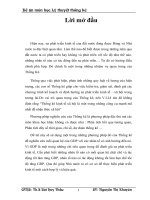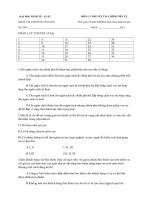slide môn lý thuyết dịch TRANSLATION METHODS
Bạn đang xem bản rút gọn của tài liệu. Xem và tải ngay bản đầy đủ của tài liệu tại đây (305.29 KB, 27 trang )
TRANSLATI
ON
METHODS
Translation Theory 1
CORE READING
A TEXTBOOK OF TRANSLATION
Peter Newmark (1988)
Translation methods
SL
Word for word translation
Literal translation
Faithful translation
Semantic translation
TL
Adaptation
Free translation
Idiomatic translation
Communicative translation
I- Word for word
translation
SL word-order is
preserved
Non-grammatical
Words are
translated by their
most common
meanings, out of
context
Used for
General
information
about SL
Pre-translation
process of
difficult text in
order to gain
sense of
meaning
II - Literal translation
SL grammatical structures
are converted to their
nearest equivalent in the
TL
BUT words are still
translated singly, out of
context.
e.g.
- He is a big liar.
Anh ta lµ mét kÎ nãi dèi lín.
- He looked up at the Milky Way.
Anh nh×n lªn con ®êng mµu s÷a.
Used for
Pretranslation
process to
identify
problems
Practice
1. Love can touch us one time
And last for a lifetime
2. PetroVietnam, the state-owned oil and gas giant, has also
found itself in hot water.
3. And I must follow on the road that lies ahead,
And I won't let my heart control my head,
4. She has a sweet tooth.
III - Faithful translation
Words are translated in
context
Transfer cultural words
Does not naturalize
e.g.
+ He is as fast as a
kangaroo.
+ Nã nhanh nh mét con kanguru.
Used for
Literary
translation
Authoritative
texts
Drafts
Practice
+ Despite his looks, he’s said to be
something of a Don Juan.
+ That computer science course was a
bear.
+ This is a Mickey Mouse course but we
still have to take it because it is on the
program.
+ Carry coal to Newcastle
9
IV - Semantic translation
It is more flexible than faithful T
- Naturalizes in order to achieve aesthetic effect
(may translate cultural words with neutral or
functional terms)
- Great focus on aesthetic features of ST
(Close rendering of metaphors, collocations, technical
terms, slang, colloquialisms, unusual syntactic
structures and collocations, peculiarly used words,
neologism.
-
Used for
- Expressive texts: e.g., literature
Examples
1. Right in the heart of Hanoi, Hoan Kiem Lake
is an enchanting body of water, a peaceful oasis
away from all the hustle and bustle of the city.
N»m ngay gi÷a tr¸i tim Hµ Néi, hå Hoµn KiÕm
lµ mét hå níc ®Ñp mª hån, mét èc ®¶o yªn b×nh
t¸ch biÖt víi tất cả những gi ồn ào tấp nập
của thành phố
Practice
1. She has a sunny smile on her face.
2. All men are created equal. They are
endowed by their Creator with certain
inalienable rights, among these are Life,
Liberty, and the pursuit of Happiness"
(the Declaration of Independence of the
United States of America in 1776)
12
V - Communicative
translation
freer than semantic translation
gives priority to the effectiveness of the
message to be communicated.
focuses on factors such as readability
and naturalness
Used for
informative texts
Semantic translation vs.
communicative translation
Right in the heart of Hanoi, Hoan Kiem Lake is
an enchanting body of water, a peaceful oasis
away from all the hustle and bustle of the city.
S. Nằm ngay giữa trái tim Hà Nội, hồ Hoàn Kiếm
là một hồ nớc đẹp mê hồn, một ốc đảo yên bình
tách biệt với sự hối hả bận rộn của thành phố.
C. Hồ Hoàn Kiếm là một hồ nớc đẹp, yên tĩnh
nằm ở trung tâm Hà Nội ồn ào.
Semantic translation vs.
communicative translation
1. Nhà có chó dữ.
S. There is a fierce dog in the house.
C. Beware of the dog.
2. Keep off the grass.
S. Tránh xa bãi cỏ.
C. Không đợc dẫm lên cỏ.
3. Her face is all her fortune.
S. Bộ măt là tất cả vốn liếng của cô nàng.
C. Con ấy chỉ đợc mỗi cái xinh.
Semantic translation vs. communicative translation
SEMANTIC
TRANSLATION
•Written
at author’s linguistic level
COMMUNICATIVE TRANSLATION
•Written
at readership’s linguistic
level
•Used
for expressive texts
•Expressive
for informative texts
components rendered
closely/literally
•Normalized
•Personal
and individual
•Social
to over-translate
•Tends
•Tends
to under-translate
nuances of meaning
•Pursues
•Inferior
to its original
•Better
•Less
to interpret
freedom
or toned down, neutral
terms
•Pursues
•Has
15
•Used
•Has
message
than its original
to explain
•More
freedom
Practice
"The country is developing so fast, they need
to change the attitude and the conduct of the
people, but it is not going to happen in one
day," he said. Drivers typically don't look
before darting into traffic or cutting across
multiple lanes of cars, motorbikes and
bicycles in a "you-look-out-for-me" driving
culture.
(Vietnam
launches war on deadly traffic)
Note: There is no one communicative nor one
semantic method of translating a text - these
are in fact widely overlapping bands of
methods. A translation can be more, or less,
semantic - more, or less, communicative even a particular section or sentence can be
treated more communicatively or less
semantically. (Newmark)
VI - Idiomatic translation
18
Reproduce the ’message’ of the original
Prefers colloquialisms and idioms which
do not exist in the original
Outcome: lively, ’natural’ translation
Practice: Idiomatic
translation
Kh«ng ai nghe lêi khuyªn cña c« Êy c¶.
Her advice fell on deaf ears.
Nã rÊt bíng bØnh.
He is as stubborn as a mule.
Chë cñi vÒ rõng
Carry coal to Newcastle
Practice
- No money, no honey
- Haste makes waste
- Timid as a rabbit
- Make hay while the Sun shines
- Bite the bullet
VII - Free translation
21
Reproduce the matter without the manner;
the content without the form of the
original
Paraphrases much larger than the original
Used for
Informative translation
In-house publication
PRACTICE
Heartease (pansy) is used again for healing
the heart. It is for disappointment in love,
and in separation
Hoa păng-xê cũng được dùng để chữa
lành các vết thương lòng. Nó xoa diụ sự
thất vọng trong tình yêu, và cả nỗi đau
23
VIII - Adaptation
The freest form of translation
Preserves the theme, plots, characters only
The SL culture is converted to the TL culture
A kind of rewriting the text in translation
Used for
Plays, poems, songs, advertising, tourism
Vì Sao?
Bữa trước, riêng hai dưới
nắng đào,
Nhìn tôi cô muốn hỏi "vì
sao ?"
Khi tôi đến kiếm trên môi đẹp
Một thoáng cười yêu thỏa
khát khao.
Vì sao giáp mặt buổi đầu tiên,
Tôi đã đày thân giữa xứ phiền,
Không thể vô tình qua trước
cửa,
Biết rằng gặp gỡ đã vô duyên?
……………………..
Why?
The other day, we met in bright
sunshine
Looking at me, you wanted to
ask "Why?"
When I came there to see on
your lips fine
A hint of smile that so much
pleased my eye.
Why was it that even on the
first day
I was so soon banished to great
sadness.
Hardly had I stepped in across
the way
Than I knew right then that
we'd be loveless.
Translated by Thomas D. Le
9 May 2004
25
Vietnamese Version 1
’Mái nhà xưa yêu dấu,
Bức tường rêu phong cũ nơi cậu bé qua những ngày thơ
ấu.
Muốn mình mau khôn lớn.
Giữa lụa là yên ấm, em ngồi ước mơ bước chân giang
hồ.
Mơ bay theo cánh chim ngang trời, biển xa núi chơi vơi.
Mơ bay đi khát khao cuộc đời. Một đêm nhớ tiếng ai ru
hời.”









